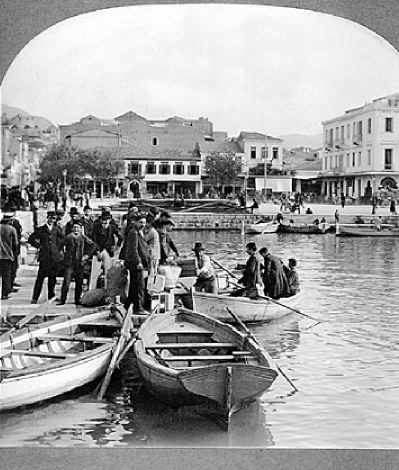 |
||
|
A Journey to the Promised Land By Christy Papadopoulou |
||
|
The Greek-American experience over a period of 90 years is unveiled in a photo show at the Benaki At the end of the 19th and for the larger part of the 20th century, thousands of Greeks travelled to America - a haven for the world's immigrants - in search of a better future. The history of the Greek community and its struggle for survival over a period of 90 years is brought to light in a photo exhibition running at the Benaki Museum through to February 25. Featuring a hundred photos from US archives, Journey - The Greek American Dream is intended as a supporting event to director Maria Iliou and historian Alexandros Kitroeff's documentary of the same title. In a year's time the joint project spotlighting the Greek diaspora will be completed with an accompanying publication by Potamos editions. |
 Greek immigrants embarking for America in Patra |
|
Like Iliou's documentary, the exhibition is organised in three sections: Immigrants (1890-1920), American Citizens (1920-1960) and The Revival of Ethnicity (1960-1980). It was the currant crisis in Southern Greece which originally triggered a large wave of migration in the 1890s. Visitors to the Benaki follow the Greek travellers - most of whom embarked from the port of Patra - as they board small ships to take them to Trieste, Marseilles, Naples and Genoa before embarking on ocean-going boats. Once reaching the Ellis Island - the main immigration point - medical tests would start. A fee of 15-20 dollars and a good health would secure them entry to the so-called Promised Land. In a couple of photos immigrants having just passed the stressful inspection process pose in national costume to honour their new land. Newcomers found low-paid employment through the padroni, who withheld part of their clients' monthly wages as compensation. Many of them - children included - worked in shoe-polishing parlours, others in mines and railway stations. In Florida's Tarpon Springs they took up sponge-diving but it was really Chicago that became the centre of Hellenism. As Greek immigrants started to settle down, the feeling of the community - boosted by schools, the church and Greek newspapers - was further strengthened through leisure activities. The immigrants' smooth integration into the American society - a process which involved their gradual 'Americanisation' - did not mean severing the roots. The exhibition follows Greek immigrants through the Depression period (a child is seen eating raisin biscuits sent by the Red Cross) as well as World War II when thousands of Greeks enlisted in the US army, thus winning Americans' high esteem. The 50s saw the improvement of the Greek-Americans' status. Greek-owned fast-food restaurants - known as diners - offered them the financial stability that enabled them to provide their children with better education. At the same time, the second largest migratory wave after the 1890-1922 one, brought to America not only common people but also soon-to-be celebrities from the worlds of art and science. Amongst the most famous Greeks pictured are composer Dimitri Mitropoulos, soprano Maria Callas and filmmaker Elia Kazan, whose 1963 film America, America is also about the migratory experience. The discovery of Leon Pantoti's photo archive in the 80s - also the time when many relevant publications appeared - coincides with the Greek Americans' taking pride in their 'otherness'. Apart from its aesthetic merit, Journey has an additional sociopolitical significance. Organisers point to a change of Greece's image from a country which exported immigrants to one that imports them. "The acceptance of otherness," as Iliou points out, "should not provoke fear but be held dear in a society which is not afraid of moving forward." |
||
(Posting Date 6 March 2007) HCS readers can view other excellent articles by this writer in the News & Issues and other sections of our extensive, permanent archives at the URL http://www.helleniccomserve.com./contents.html
All articles of Athens News appearing on HCS have been reprinted with permission. |
||
|
||
|
2000 © Hellenic Communication Service, L.L.C. All Rights Reserved. http://www.HellenicComServe.com |
||

